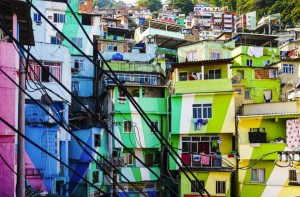Attitudes towards the favelas of South America have changed several times over the years. We want to have a closer look at this today, especially the impact of painting the buildings bright colours. Then, if you need help from architects in London, you can speak to us.
Development
 The first favela was Providência in Rio de Janeiro, Brazil. It developed in the 19th century because soldiers returning from the War of Canudos and workers from the countryside couldn’t afford expensive urban housing. So, they built their own homes on the hill, creating an unofficial settlement.
The first favela was Providência in Rio de Janeiro, Brazil. It developed in the 19th century because soldiers returning from the War of Canudos and workers from the countryside couldn’t afford expensive urban housing. So, they built their own homes on the hill, creating an unofficial settlement.
Today the biggest favela in Brazil is Sol Nascente in Brasilia. There are favelas in hundreds of municipalities across the country. You can also find them in several other South American countries, including Argentina, Bolivia, Columbia, and Peru. There are some in Central America too, in countries like Honduras and Mexico.
Opinions
Originally, the government in Brazil saw the favelas as a problem. At first they thought it was solvable, leading to numerous plans from the 30s to the 50s. However, by the 80s they knew the issue was far more complex. So, they painted them as huge concerns because the communities were a hotspot for organised crime and drugs. People would fear to go into them.
More recently though, there has been a shift in the opinion. More and more people now see the favelas as a vital part of the cities and communities with cultural significance. They can attract visitors, with some organisers even offering tours. The vibrant colours of the homes play a major part in this. It can be inspiring to us as architects in London, showing the power of colour.
Why painting?
There are many different benefits to painting the buildings. For one, it improves the lives of the local people. It builds ties to the community, celebrating the identity, culture, and traditions. It can also be transformative, bringing new life to the area. Plus, it is inspiring to local and international artists.
Famously, the Santa Marta favela in Rio got global attention in 2006 thanks to work from Dutch artists. They had discussions with the local community and then began painting buildings in all kinds of bright colourful shades. It brought global attention to the community. Ultimately, the project became a social program for the area with locals actively getting involved.
The success of the project in Santa Marta inspired other work in different areas. Paraisópolis in São Paulo is one of the most impressive. The goal here is not just to paint the buildings. It is also to help the economy by sourcing materials from local businesses. Even more importantly, it provides training to give local workers the skills they need and development opportunities.
Do you want to work with architects in London?
Painting is not just something that can help in favelas. It can build better communities in all kinds of residential areas, including urban and suburban spots. Famously, Renzo Piano did the Central St. Giles project in Camden, London in 2010. It is now one of the most colourful mixed use developments in the West End. It got praise because the colours give the area a personality and encourage belonging and urban living.
If you have a project in mind and want to choose colours to ensure it makes a great impression, you can talk to us. Coffey Architects knows how to use colour effectively, even in small splashes. We are also one of the most creative architects in London.
